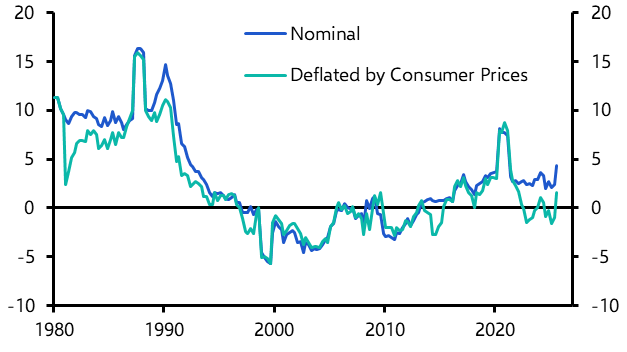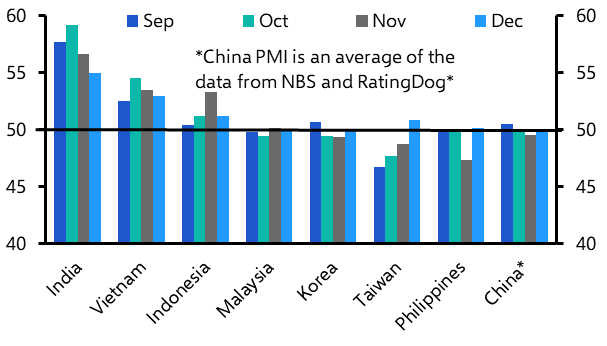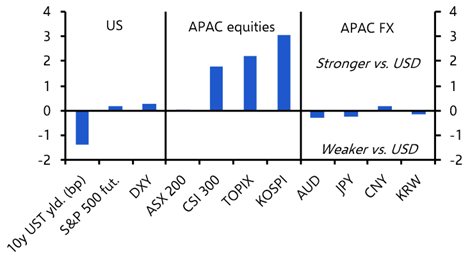To death and taxes we can also add the inevitability of a default by Argentina’s government every decade or so. The announcement last month that Buenos Aires will attempt to “re-profile” its debt payments is really just default by another name and sets the stage for months (and potentially years) of tortuous negotiations with creditors. Assuming that these produce an agreement it means that Argentina will have defaulted on its debt obligations four times in the past three decades.
The debt crisis in Argentina is notable for two reasons. The first is that it was utterly predictable. A sharp rise in the issuance of dollar debt combined with a failure to get to grips with runaway inflation was always likely to be a recipe for disaster. This is because the very high rates of inflation erode external competitiveness and will tend to put downward pressure on the exchange rate. At the same time, however, a fall in the exchange rate raises the local currency cost of servicing foreign currency debt – leading to balance sheet vulnerabilities that raise the risk of default.
The problem in Argentina’s case was that everything was done in the extreme. Since Argentina regained access to global debt markets in 2016 it has issued over $40bn in dollar-denominated debt (equivalent to just under 10% of GDP). However, this came after a 10-year period in which inflation had averaged around 25% a year. As a consequence, Argentina went on a dollar debt binge at a time when the real exchange rate was extremely overvalued and it was a matter of when not if the nominal exchange rate would have to adjust. The fact that inflation then continued to run at rates of 30% or so made a bad situation worse.
We argued that Argentina was on a path that could lead to crisis as far back as 2017. Two things are now needed to stabilise the situation. The first is a debt restructuring that reduces the immediate pressure on the Treasury. The second is a concerted effort to tame inflation and rein in the current account deficit. This will have to include a combination of tighter monetary and fiscal policy and a weaker currency. But given the likely outcome of October’s elections there’s good reason to be sceptical about the chances of a meaningful improvement in policy.The second reason why Argentina’s troubles are notable is that there has been little contagion to other emerging markets. This is a break with the past, when a crisis in one EM has often triggered a general investor pullback from “risky” assets, thereby causing problems in others. Argentina’s last default in 2001 caused a wobble in Brazilian markets. The Asian financial crisis in 1997-98 started in Thailand but quickly spread across the region. And the Mexican “Tequila” crisis in 1994 caused tremors elsewhere in Latin America. Yet this time around, EMs have shrugged off the latest problems in Argentina.
This difference in outcomes reflects a fundamental improvement in the balance sheets of most emerging markets over the past couple of decades. The reason that, in the past, a crisis in one country would ripple to others is that it would spur investors to look for economies with similar vulnerabilities. This would then cause a pullback of capital from these economies, which in turn would be the trigger for further crises.
But Argentina is now an outlier in the emerging world. Most EMs now issue debt in local rather than foreign currency. In 2000 around a quarter of EM sovereign debt was denominated in foreign currency. Today that share has fallen to just 5%. At the same time, EMs have increased their holdings of foreign currency assets that can be set against the foreign liabilities they do have. In 2000 EM foreign exchange reserves averaged 10% of GDP. Today they average close to 25%. Add in the fact that inflation is running in the low single-digits in most emerging economies and current account deficits are, with one or two exceptions, relatively small, and it’s now hard to find an EM with similar vulnerabilities to Argentina. (Argentina aside, the two EMs where the balance of payment risks are greatest are Zambia and Lebanon.)
None of this means that emerging economies are necessarily in a good place. According to our analysis, the 2000s was the first decade since reliable data began in the 1950s in which EM incomes converged with those in the developed world. Yet in our view this “Golden Era” of EM growth is now over. This has little to do with the current trade war – although, as we’ll argue in a series of forthcoming conferences, mounting evidence that we have reached “peak” globalisation doesn’t help. Instead, the bigger concern is that the rapid growth of the 2000s was, in our view, driven by a series of one-off factors that have now faded. The result is that emerging markets have entered a period of permanently weaker expansion. The challenge now facing most EM policymakers is therefore not how to ensure macro stability but rather how to avoid growth becoming lodged at structurally low rates. In this respect, Argentina is an anachronism – it’s still fighting yesterday’s battles.
In case you missed it:
(Requires login)
- Our Chief Europe Economist, Andrew Kenningham, gives his take on last week’s ECB meeting and assesses what else policymakers could do to stimulate growth and inflation.
- Our US team looks ahead to this week’s Fed meeting…
- …and explains why President Trump should be careful what he wishes for when calling for negative rates.




